Auto Anthro: Why racing fans can’t stand some racing movies
Jack Swansey holds a degree in anthropology with a focus on car culture, and he is the world’s leading ethnographic authority (by default, if you must know) on NASCAR fandom. His love of the automobile fuels him to discover what cars mean to the people who own, drive, and love them. Read more Auto Anthro here. —EW
Racing movies are a Hollywood fixture, an action and drama genre to which cinematic storytellers regularly return. You might have noticed, however, that these films tend to be polarizing; mainstream audiences and real-life racing fans rarely agree on what makes a good racing movie or a bad one. I’ve met true gearheads who will defend Days of Thunder, Cannonball Run, or Sylvester Stallone’s Driven to their dying breaths, despite filmmaking gaffes or cheesy dialogue. And for every Ford v Ferrari that earns broad critical acclaim and undeniable box-office success, there’s a chorus of car enthusiasts eager to pick apart its every technical and historical inaccuracy.

The recent Gran Turismo summer blockbuster produced such a familiar dynamic. Despite $117M in box-office sales (against a $60M budget), car-savvy critics contend that it plays fast and loose (“on the edge of out of control,” some might say) with the order of events in the real-life racing career of Jann Mardenborough.
To understand from what or where these different perspectives stem, it helps to break down the medium of film into the most common narrative building blocks. There is a series of story beats that tend to occur in good movies—I often see screenwriter Christopher Vogler’s 12-step “Hero’s Journey”—but the most basic version is the famous “three-act structure.”
In the three-act form, the first act establishes the world in which the hero’s journey takes place. This act also defines what the journey is going to be about. In the beginning of Gran Turismo, Jann Mardenborough (Archie Madekwe) has a loving father who nevertheless disapproves of his son’s only ambition: to race cars. Success in this field seems impossible, since Jann’s only competitive experience behind the wheel is in the virtual world of PlayStation’s Gran Turismo. His eventual invitation to Nissan’s GT Academy, which gives gamers the chance to train as real-life racing drivers, serves as what Vogler would label the “call to adventure.” That opportunity is what sets the story in motion. Through it Jann meets a mentor figure, Jack Salter, (David Harbor) to help him improve his skills. Jann ultimately signs a contract with Nissan—“crossing the threshold” as Vogler would put it—into the world of professional racing.
Act two, usually the longest act in a good film, shows Mardenborough exploring and adjusting to his new environment in motorsports. He experiences success in some races and failure in others, eventually arriving at his lowest emotional point. In the case of the Gran Turismo movie, this nadir is his real-life accident in the Flugplatz section of the Nürburgring, in a VLN endurance race that claimed the life of a spectator. In reality, this crash happened in 2015, two years after the events that inspired the third act of Gran Turismo, in which the hero finds the power deep inside himself (“resurrection,” to Vogler) and emerges changed, if not triumphant.
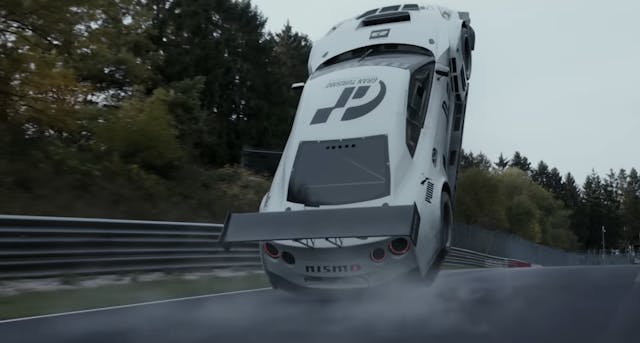
According to Ben Queen, the screenwriter of Pixar’s Cars 2 and Cars 3, basic facts about racing make it tailor-made for a great film narrative: “built-in protagonists and antagonists—the other characters racing against our guy —the team element, the authenticity of the world.” You can check off all Vogler’s boxes here: the mentor, the threshold, et cetera—but it goes deeper than that. Because of humanity’s instinctive love of a good story, racing is a narrative medium in real life.

Vogler’s “Hero’s Journey” is directly based on the work of Joseph Campbell, the scholar widely credited with identifying the “monomyth” that bridges Hollywood scripts and Homeric poetry. (There are narrative structures other than Hollywood’s three acts: Shakespeare plays are told in five, for instance, and Game of Thrones’ many twists and turns resist easy categorization.) Campbell argues that humanity, throughout history, has always mythologized stories about heroes, be they real or fictional.
NASCAR, for instance, has stood the test of time because of the story arcs of its driver-heroes. The 1992 Hooters 500 at Atlanta Motor Speedway witnessed six drivers enter with a shot at the Winston Cup championship, but it soon came down to two: Bill Elliott, NASCAR’s most popular driver who drove for Junior Johnson’s Budweiser-funded powerhouse operation, and Alan Kulwicki, a Wisconsinite outsider who built his own engines. While battling Elliott for the win, Kulwicki’s Ford Underbird (he had special permission from Ford to run without the Th-) broke the first three gears in its transmission, seemingly dooming Kulwicki’s championship charge. A brilliant strategy call to delay pitting and lead the pack for one lap more than Elliott earned Kulwicki just enough bonus points to win the title, though he lost the race.
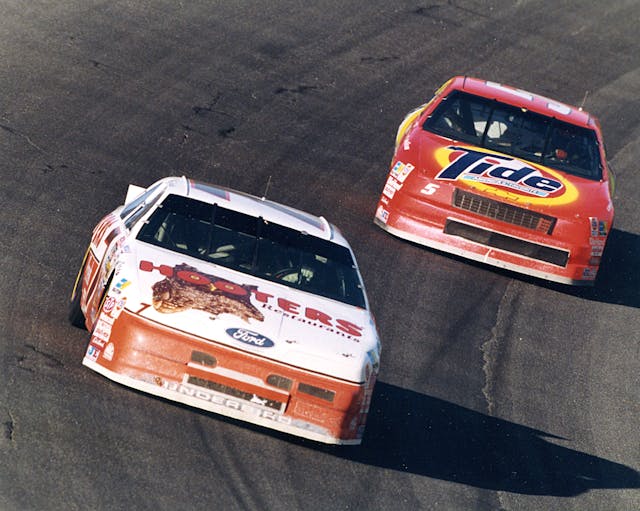
It’s the monomyth, a perfect hero’s journey (unless you’re an Elliott fan). But this wasn’t a movie, which means the real-world race lasted three hours, 44 minutes, and 20 seconds. Fans had been watching Kulwicki’s entire career point to that moment; at the same time, Richard Petty was making his final Cup start in that race and Jeff Gordon was making his first. That race, considered by many NASCAR’s greatest, takes on its emotional meaning only in the context of the rest of the sport’s history. A feature film doesn’t have the time to establish that depth of context. As Queen warned me: “Even if the cars are moving forward, the story might not be.”
Racing’s narrative structure, so familiar to fans of the sport, is near-impossible to drop directly to the silver screen. Just like a novel or a TV show, it has to be adapted. And adaptations always make changes to the source material. They have to, in order to make it work in a new medium, but those changes can be frustrating to those in the know. Anyone expecting the film adaptation to be just like the book is almost inevitably disappointed. It can’t be exactly like the book because it’s a movie, which means a movie about racing will never be just like watching a race.
If done well, adaptation adds something only the new medium can provide.
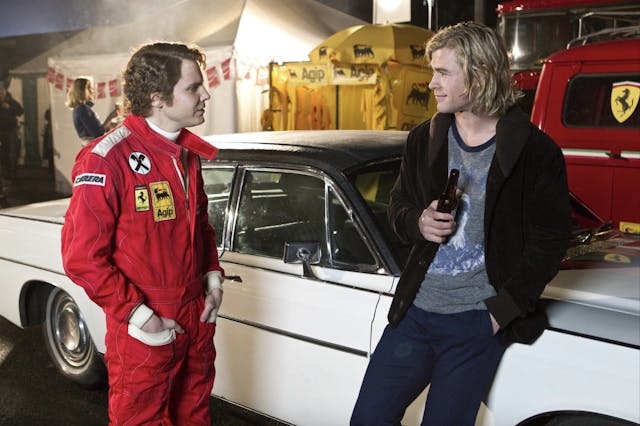
Let’s take a look at 2013’s Rush. The film tells the story of James Hunt and Niki Lauda’s rivalry leading up to the 1976 Formula 1 championship. It ends with a quiet scene in an airplane hangar, with Hunt (Chris Hemsworth) and Lauda (Daniel Brühl) reconnecting weeks after the season is complete. It’s only the two drivers on location—no media, no fans, no cars even—and they just talk. They argue about the rainy conditions at the Japanese Grand Prix, when Lauda decided the conditions were too dangerous to drive; Hunt continued on to win the title. They argue about their different approaches to racing, yes, but it’s from the audience’s perspective in that narrative moment that we understand something more: They’re really arguing about life.
Lauda then delivers a monologue in voice-over, during which the film intercuts archival footage of the real Hunt and Lauda, with Brühl watching Hemsworth walk away. “People always think of us as rivals,” Brühl’s Lauda says, “but he was among the very few I liked … and even fewer that I respected. He remains the only person I envied.”
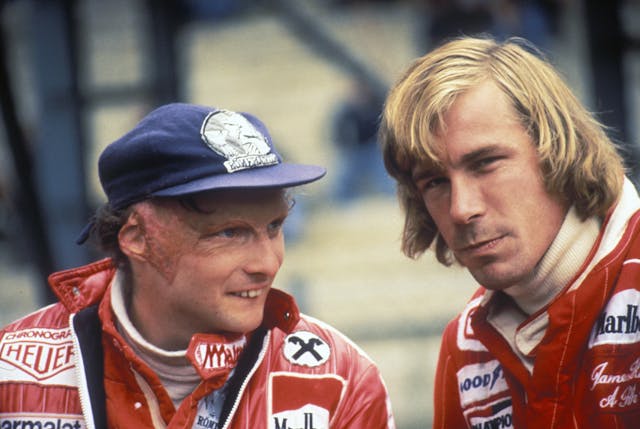
You can read books and articles about the 1976 Formula 1 season and the lives of Hunt and Lauda. Maybe you were lucky enough to have watched them race in real time. Their rivalry and friendship is rich with subtext, two very different men with very different philosophies that came into peak conflict that day at Fuji Speedway. Rush, the film, is about delivering the essence of that tension, whether or not the audience has a particular affinity or background in racing. It’s that rare film that succeeds in pleasing both casual viewers and serious racing fans.
With Ferrari coming out on Christmas Day this year, Michael Mann has his work cut out to thread that same needle. We car people are a tough crowd, but the movies that get it right we remember forever.
***
Check out the Hagerty Media homepage so you don’t miss a single story, or better yet, bookmark it. To get our best stories delivered right to your inbox, subscribe to our newsletters.
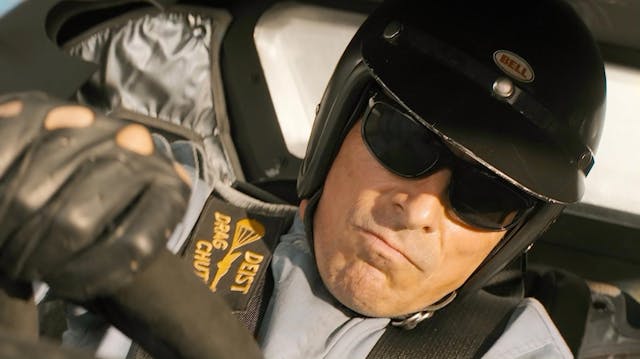




The Only real problem with Ford v Ferrari was the historical inaccuracies. Other than that it was the best racing movie ever made. Thrilling, no nonsense love interest filler, genuine emotions. It’s a shame because it nagged me as I sat there in the theater. Though I loved it after and was on a real high after coming out and drove too fast in my old 911 on the way home. The thing is, none of those really needed to happen. It could have been more accurate and satisfying to serious car guys without losing any of the greatness that was there. You do not have to cover everything, but when you do, accurate details are really important to trivia nuts — like the people who read this site.
I agree that Mann has a task on his hands, but he’ll overcome it if he can make a movie as thrilling and emotional as Ford v Ferrari, but stick to historical accuracy in the outline!
Ford vs. Ferrari was a dud. First let’s start with the casting. Bale was great (when he wasn’t in the car), but Damon as Carroll Shelby? He was horrible. The screen regularly showed historical inaccuracies…modular wheels and low profile tires didn’t exist until the late ’70’s. But it was the racing scenes where the movie fell apart. While the look of the cars and scenes were great, racing drivers are fairly stoic behind the wheel. McQueen and the other drivers in “Le Mans” portray this properly. Drivers don’t hoot and holler behind the wheel and they certainly don’t look to the side at their competition at 200mph. The exterior shots of the action had no continuity nor context…just cars going around corners. In “Le Mans” each corner of Le Sarthe circuit followed the actual previous corner. A 3:30 real lap of the circuit lasted 3:30 on screen. And some of the scenes in FvsF, most especially at Daytona, showed CGI cars going around 50mph corners at 150mph. The scene with Henry Ford II crying in the car was ridiculous. And the worst….the absolute worst…moment was the silly “Wait for it, wait for it, NOW” scene that they aired not once, but TWICE. When I flew to France this past June for the race, I gave the film a second chance on my flight to Iceland, and was super sorry that I did. That compares very poorly to “Le Mans” which I never get tired of seeing, and “Rush” which I saw three times(!) in the theater within two weeks during its initial release.
I could go on. The Ferrari factory had front-engined F1 cars from the early 1950’s. And for those of us who know that Miles did in fact race at Le Mans in 1965…rather than being forced to stay home and listen to the race on the radio in order to create some sort of fake narrative…is just so much Hollywood BS.
The only Nascar Cup race I have ever been to live was the 1992 Hooters 500 at Atlanta. I bought my ticket the day Richard Petty, my childhood hero, announced his retirement . I drove from north of Toronto to the track, and was one of the over 180,000 people who attended the event. I didn’t get out of the parking area until mid day Monday. I still have my autographed by the King track program.
Well Grand Prix was probably the best, LeMans was amazing because when Steve McQueen said “racing is life everything else is what it takes to get there” in Le Mans I truly believed him this was a moment of non acting.
Seeing Matt Damon and Christian Bale in Ford vs Ferrari was great but neither one could ever make statements like McQueen or James Garner because this was obviously just a job to them- next week they are Dick Cheney or Jason Bourne. One group read the book, the others read the cliff notes, and gearheads know which gang would most likely know how to degree a cam!!
As both a motor racing and baseball fan, and with both sports having many films, it is worth comparing the two genres. The baseball films that work best (e.g., “Field of Dreams” and “Bull Durham”) are more allegorical than any attempt to be historic. Ones that are loosely historic (“League of Their Own” and “Eight Men Out”) make big statements. A few biographical ones (“Fear Strikes Out”) are poignantly human. The good ones don’t dwell on historic accuracy. Similarly the good racing films don’t dwell (at least in the good parts) on accuracy. “Rush” is often inaccurate or more correctly, very condensed, but when it rings true about the Hunt-Lauda relationship then the film shines and its inaccuracies can be forgiven. “Ford v Ferrari” doesn’t allow that. While the Miles and Shelby characters give it depth, it so fundamentally flawed technically and historically that few fans can forgive that. “Grand Prix” and “Winning” come a little closer to the “Field of Dreams” and “Bull Durham” ethos in that they emphasize the romance (in the former) and the human element in the latter. Neither one pretends to represent history.
While “Bull Durham” was a comedy, it was far more subtle than the over the top “Talladega Nights”. Moreover “Bull Durham” was a pretty accurate description of minor league life. Racing needs both a “Bull Durham” and a highly allegorical “Field of Dreams”. There was one motorsports film which was perhaps the best combo of history and pathos, “The World’s Fastest Indian.” I have friends in the Land Speed Record world who were there and knew the real Bert Munro. They concur that while from a purist point of view some of the records and facts were altered, the film accurately and sympathetically captured the era and the people.
I guess “Bobby Deerfield” with Al Pacino doesn’t even rate “bottom of the barrel”? I saw it when it came out in 1977 but never again.
Kulwicki Is actually battling Ricky Rudd in the picture, not Bill Elliott. I actually thought this might be on purpose considering the articles focus, to see how many chimed in!
The worst movie about racing is, at least in my opinion, “The Big Wheel” with Mickey Rooney. There’s a little bit of good racing scenes, but the story is ridiculous, the ending so unlikely as to be laughable, and having drivers look at each other, then gritting their teeth while racing is simply off-the-charts bad acting. Yet, it’s on my shelf.
“Grand Prix” set a pretty high mark, although at the time it seemed obligatory for a racing movie to have somebody die in a car, and that was a bit trite, even then. Although in the day, it seemed to happen a lot.
“Le Mans” is probably my favorite racing movie, because it’s more about racing than anything else. Sure, there’s a death hanging over the event, but it happened the previous year, so it’s not really important to what unfolds on the screen.
They could start with realistic actors. Matt Damon as Carroll Shelby, Adam Driver as Enzo👎🏽 Rush andKen Miles we’re right 👍
Make a movie about Mickey Thompson, he was in almost every motor sport there was and he started from nothing.